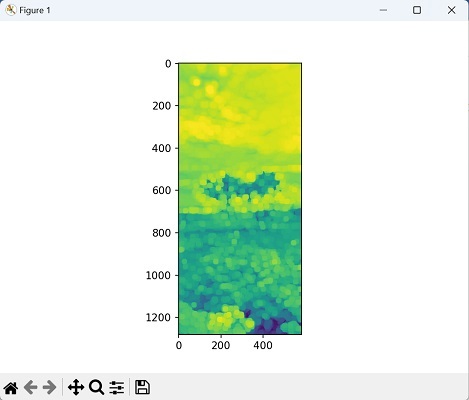
- Mahotas 教程
- Mahotas - 首頁
- Mahotas - 簡介
- Mahotas - 計算機視覺
- Mahotas - 歷史
- Mahotas - 特性
- Mahotas - 安裝
- Mahotas 影像處理
- Mahotas - 影像處理
- Mahotas - 載入影像
- Mahotas - 載入灰度影像
- Mahotas - 顯示影像
- Mahotas - 顯示影像形狀
- Mahotas - 儲存影像
- Mahotas - 影像質心
- Mahotas - 影像卷積
- Mahotas - 建立RGB影像
- Mahotas - 影像尤拉數
- Mahotas - 影像中零的比例
- Mahotas - 獲取影像矩
- Mahotas - 影像區域性最大值
- Mahotas - 影像橢圓軸
- Mahotas - 影像拉伸RGB
- Mahotas 顏色空間轉換
- Mahotas - 顏色空間轉換
- Mahotas - RGB轉灰度轉換
- Mahotas - RGB轉LAB轉換
- Mahotas - RGB轉棕褐色
- Mahotas - RGB轉XYZ轉換
- Mahotas - XYZ轉LAB轉換
- Mahotas - XYZ轉RGB轉換
- Mahotas - 增加伽馬校正
- Mahotas - 拉伸伽馬校正
- Mahotas 標記影像函式
- Mahotas - 標記影像函式
- Mahotas - 標記影像
- Mahotas - 過濾區域
- Mahotas - 邊界畫素
- Mahotas - 形態學運算
- Mahotas - 形態學運算元
- Mahotas - 查詢影像均值
- Mahotas - 裁剪影像
- Mahotas - 影像離心率
- Mahotas - 影像疊加
- Mahotas - 影像圓度
- Mahotas - 影像縮放
- Mahotas - 影像直方圖
- Mahotas - 影像膨脹
- Mahotas - 影像腐蝕
- Mahotas - 分水嶺演算法
- Mahotas - 影像開運算
- Mahotas - 影像閉運算
- Mahotas - 填充影像空洞
- Mahotas - 條件膨脹影像
- Mahotas - 條件腐蝕影像
- Mahotas - 影像條件分水嶺演算法
- Mahotas - 影像區域性最小值
- Mahotas - 影像區域最大值
- Mahotas - 影像區域最小值
- Mahotas - 高階概念
- Mahotas - 影像閾值化
- Mahotas - 設定閾值
- Mahotas - 軟閾值
- Mahotas - Bernsen區域性閾值化
- Mahotas - 小波變換
- 製作影像小波中心
- Mahotas - 距離變換
- Mahotas - 多邊形工具
- Mahotas - 區域性二值模式
- 閾值鄰域統計
- Mahotas - Haralic 特徵
- 標記區域的權重
- Mahotas - Zernike 特徵
- Mahotas - Zernike 矩
- Mahotas - 排序濾波器
- Mahotas - 二維拉普拉斯濾波器
- Mahotas - 多數濾波器
- Mahotas - 均值濾波器
- Mahotas - 中值濾波器
- Mahotas - Otsu 方法
- Mahotas - 高斯濾波
- Mahotas - Hit & Miss 變換
- Mahotas - 標記最大值陣列
- Mahotas - 影像均值
- Mahotas - SURF 密集點
- Mahotas - SURF 積分影像
- Mahotas - Haar 變換
- 突出影像最大值
- 計算線性二值模式
- 獲取標記的邊界
- 反轉 Haar 變換
- Riddler-Calvard 方法
- 標記區域的大小
- Mahotas - 模板匹配
- 加速魯棒特徵
- 去除邊界標記
- Mahotas - Daubechies 小波
- Mahotas - Sobel 邊緣檢測
Mahotas - 影像膨脹
在影像處理中,影像膨脹是指擴充套件影像的畫素。
膨脹過程會在影像邊緣新增畫素。這是因為演算法檢視影像中的每個畫素並檢查其相鄰畫素。
如果任何相鄰畫素是物體的一部分,它會將這些畫素新增到物體的邊界。
在 Mahotas 中膨脹影像
在 Mahotas 中膨脹影像是指向影像中區域的邊界新增畫素數。此操作通常用於增強或修改影像中的形狀和結構。
我們可以使用dilate()函式在 mahotas 中膨脹影像。它用於使用結構元素 B 擴充套件元素 A。
結構元素是一個小的矩陣或形狀,定義每個畫素周圍的鄰域。它用於確定在膨脹過程中應考慮哪些畫素。
mahotas.dilate() 函式
mahotas.dilate() 函式將輸入影像和結構元素作為引數,並返回一個新的 NumPy 陣列。
輸出畫素的值由鄰域中所有畫素的最大值確定。如果任何相鄰畫素的值為 1,則輸出畫素設定為 1。
dilate() 函式逐畫素掃描影像,並檢查由結構元素定義的鄰域。
如果任何相鄰畫素是物體的一部分,膨脹操作會將這些畫素新增到物體的邊界,使其變大。
語法
以下是 mahotas 中 dilate() 函式的基本語法:
mahotas.dilate(A, Bc=None, out=None, output=None)
其中,
A − 它是將對其執行膨脹的輸入影像。它可以是表示灰度或二值影像資料的二維或三維 NumPy 陣列。
Bc (可選) − 它是用於膨脹的結構元素。預設為 None。
out (已棄用) / output (可選) − 它指定用於儲存結果的輸出陣列。如果未提供,則建立一個新陣列並將其作為輸出返回。
示例
以下是使用 dilate() 函式在 mahotas 中膨脹影像的基本示例:
import mahotas as mh
import matplotlib.pyplot as plt
import numpy as np
image = mh.imread('nature.jpeg', as_grey=True).astype(np.uint8)
# Performing dilation with a square kernel of size 3x3
dilated_image = mh.dilate(image, Bc=mh.disk(3))
# Create a figure with subplots
fig, axes = plt.subplots(1, 2, figsize=(7,5 ))
# Display the original image
axes[0].imshow(image)
axes[0].set_title('Original Image')
axes[0].axis('off')
# Display the dilated image
axes[1].imshow(dilated_image, cmap='gray')
axes[1].set_title('Dilated Image')
axes[1].axis('off')
# Adjust the layout and display the plot
plt.tight_layout()
plt.show()
輸出
執行上述程式碼後,我們將獲得如下輸出:

使用不同的結構元素大小進行膨脹
我們還可以使用不同的結構元素大小來膨脹影像,以增強影像的不同方面。這些元素使用 Mahotas disk() 函式建立不同的大小。
透過為結構元素選擇不同的半徑或大小,我們可以獲得不同的效果。首先,我們使用最大的結構元素進行膨脹。然後,我們繼續使用較小的結構元素進行額外的膨脹。
這種方法允許我們以多種方式修改影像,增強特定特徵並獲得所需的視覺效果。
示例
在這裡,我們嘗試使用不同的結構元素大小來膨脹影像:
import mahotas as mh
import numpy as np
from pylab import imshow, show
image = mh.imread('nature.jpeg', as_grey=True).astype(np.uint8)
# Performing dilation with the largest structuring element
largest_se = mh.disk(8)
dilated_image = mh.dilate(image, Bc=largest_se)
# Performing additional dilations with smaller structuring elements
smaller_se_1 = mh.disk(2)
smaller_se_2 = mh.disk(5)
dilated_image = mh.dilate(dilated_image, Bc=smaller_se_1)
dilated_image = mh.dilate(dilated_image, Bc=smaller_se_2)
# Displaying the dilated image
imshow(dilated_image)
show()
輸出
獲得的輸出如下所示:

使用圓形核心進行膨脹
要建立圓形核心,我們可以使用 Mahotas 的 disk() 函式。透過指定所需的半徑,此函式會生成一個表示圓形核心的 NumPy 陣列。
準備好影像和圓形核心後,我們可以進行膨脹。此操作將圓形核心應用於影像的每個畫素,相應地擴充套件白色區域。
簡單來說,它增強了影像中的明亮區域,使其更大。
示例
現在,我們正在使用圓形核心膨脹影像:
import mahotas as mh
import numpy as np
from pylab import imshow, show
# Load image
image = mh.imread('sun.png', as_grey=True).astype(np.uint8)
# Circular kernel with radius 5
radius = 5
kernel = mh.disk(radius)
dilated_image = mh.dilate(image, kernel)
# Display the dilated image
imshow(dilated_image)
show()
輸出
以下是上述程式碼的輸出:
